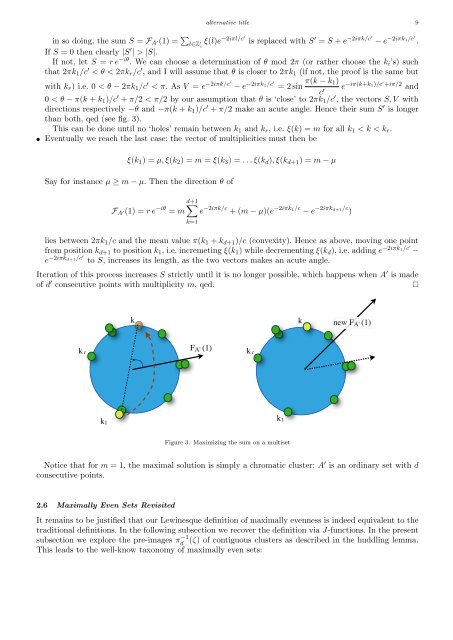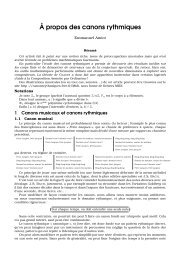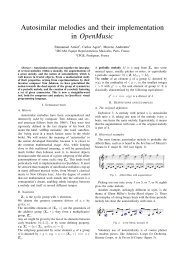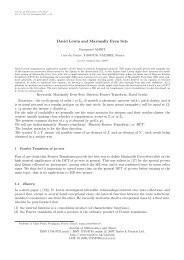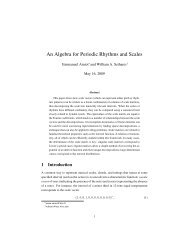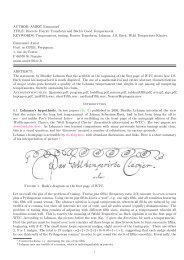Emmanuel Amiot Modèles algébriques et algorithmes pour la ...
Emmanuel Amiot Modèles algébriques et algorithmes pour la ...
Emmanuel Amiot Modèles algébriques et algorithmes pour la ...
You also want an ePaper? Increase the reach of your titles
YUMPU automatically turns print PDFs into web optimized ePapers that Google loves.
in so doing, the sum S = FA ′(1) =<br />
l∈Z ′ c<br />
alternative title 9<br />
ξ(l)e −2iπl/c′<br />
is rep<strong>la</strong>ced with S ′ = S + e −2iπk/c′<br />
− e−2iπk1/c′ .<br />
If S = 0 then clearly |S ′ | > |S|.<br />
If not, l<strong>et</strong> S = r e−iθ . We can choose a d<strong>et</strong>ermination of θ mod 2π (or rather choose the ki’s) such<br />
that 2πk1/c ′ < θ < 2πkr/c ′ , and I will assume that θ is closer to 2πk1 (if not, the proof is the same but<br />
with kr) i.e. 0 < θ − 2πk1/c ′ < π. As V = e −2iπk/c′<br />
− e−2iπk1/c′ π(k − k1)<br />
= 2 sin<br />
c ′ e−iπ(k+k1)/c′ +iπ/2 and<br />
0 < θ − π(k + k1)/c ′ + π/2 < π/2 by our assumption that θ is ‘close’ to 2πk1/c ′ , the vectors S, V with<br />
directions respectively −θ and −π(k + k1)/c ′ + π/2 make an acute angle. Hence their sum S ′ is longer<br />
than both, qed (see fig. 3).<br />
This can be done until no ‘holes’ remain b<strong>et</strong>ween k1 and kr, i.e. ξ(k) = m for all k1 < k < kr.<br />
• Eventually we reach the <strong>la</strong>st case: the vector of multiplicities must then be<br />
ξ(k1) = µ, ξ(k2) = m = ξ(k3) = . . . ξ(kd), ξ(kd+1) = m − µ<br />
Say for instance µ ≥ m − µ. Then the direction θ of<br />
FA ′(1) = r e−iθ d+1<br />
= m<br />
k=1<br />
e −2iπk/c + (m − µ)(e −2iπk1/c − e −2iπkd+1/c )<br />
lies b<strong>et</strong>ween 2πk1/c and the mean value π(k1 + kd+1)/c (convexity). Hence as above, moving one point<br />
from position kd+1 to position k1, i.e. increm<strong>et</strong>ing ξ(k1) while decrementing ξ(kd), i.e. adding e−2iπk1/c′ −<br />
e−2iπkd+1/c′ to S, increases its length, as the two vectors makes an acute angle.<br />
Iteration of this process increases S strictly until it is no longer possible, which happens when A ′ is made<br />
of d ′ consecutive points with multiplicity m, qed. <br />
k r<br />
k1<br />
k k new FA' (1)<br />
FA' (1)<br />
k r<br />
k1<br />
Figure 3. Maximizing the sum on a multis<strong>et</strong><br />
Notice that for m = 1, the maximal solution is simply a chromatic cluster: A ′ is an ordinary s<strong>et</strong> with d<br />
consecutive points.<br />
2.6 Maximally Even S<strong>et</strong>s Revisited<br />
It remains to be justified that our Lewinesque definition of maximally evenness is indeed equivalent to the<br />
traditional definitions. In the following subsection we recover the definition via J-functions. In the present<br />
subsection we explore the pre-images π −1<br />
d (ζ) of contiguous clusters as described in the huddling lemma.<br />
This leads to the well-know taxonomy of maximally even s<strong>et</strong>s:


